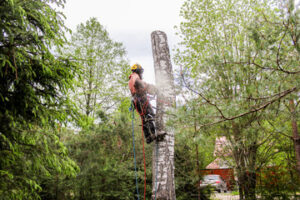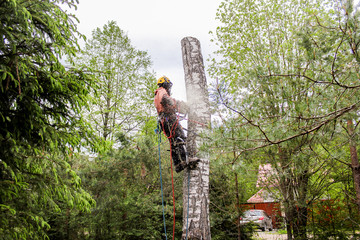Tree service plays a crucial role in maintaining the health and safety of trees in both urban and natural settings. Trees provide shade, improve air quality, and enhance the overall aesthetic of any environment.
However, they require proper care to remain healthy and structurally sound. Professional tree service ensures that trees thrive while minimizing risks to property and people. Visit Website to learn more.
Tree pruning is one of the most common services performed by professionals. Removing dead or weak branches improves the tree’s structure and health. It also reduces the risk of falling limbs during storms or strong winds. Pruning helps shape the tree and encourages healthy growth.
Tree removal is sometimes necessary when a tree becomes a safety hazard. Diseased, dying, or unstable trees can pose a threat to nearby structures and individuals. Professional tree removal ensures that the process is handled safely and efficiently. Proper disposal of the removed tree prevents environmental impact.
Stump grinding is essential after tree removal to prevent regrowth and eliminate tripping hazards. Leftover stumps can attract pests and fungi, leading to further problems. Grinding reduces the stump to mulch, which can be used for landscaping. This process ensures that the ground remains even and safe.
Tree health assessments help identify potential issues before they become serious problems. Professionals examine the tree for signs of disease, pest infestation, or structural weakness. Early intervention prevents further damage and promotes recovery. Regular assessments maintain the tree’s overall health.
Emergency tree services are critical after severe weather events. Fallen or damaged trees can block roads, damage property, and disrupt utilities. Quick response prevents further complications and ensures public safety. Professional teams have the equipment and expertise to handle emergency situations.
Tree cabling and bracing provide support to weak or split trees. Metal cables and braces reinforce the tree’s structure and prevent further damage. This technique is useful for preserving mature or historic trees. Proper installation ensures that the tree remains stable and continues to grow.
Root management is vital for maintaining tree health and preventing property damage. Overgrown roots can interfere with sidewalks, driveways, and underground utilities. Professional root pruning and barrier installation control root growth. This prevents structural damage and promotes balanced growth.
Pest control is a key part of tree maintenance. Insects and other pests can weaken trees and spread disease. Professional treatment involves identifying the pest and applying targeted solutions. Natural and chemical treatments protect the tree without harming the environment.
Disease management involves diagnosing and treating fungal, bacterial, and viral infections. Early detection is crucial for effective treatment. Professional arborists apply specialized treatments to stop the spread of disease. Maintaining proper soil and water conditions also supports recovery.
Soil care plays a major role in tree health. Poor soil quality can stunt growth and increase vulnerability to disease. Soil testing identifies nutrient deficiencies and pH imbalances. Professional soil treatments restore balance and improve root absorption.
Mulching helps retain moisture and regulate soil temperature around trees. Organic mulch provides nutrients as it decomposes. Proper mulching techniques prevent root suffocation and promote healthy growth. Mulch also reduces weed competition and soil erosion.
Tree planting requires careful planning to ensure long-term success. Professionals select species suited to the local climate and soil conditions. Proper planting depth and spacing allow trees to establish strong root systems. Ongoing care supports healthy development and growth.
Transplanting mature trees requires specialized equipment and techniques. Improper handling can damage roots and stress the tree. Professional tree service ensures that the tree is properly dug up, transported, and replanted. Post-transplant care encourages adaptation and recovery.
Tree shaping involves training young trees to develop a strong structure. Early shaping prevents future problems such as weak branches and uneven growth. Professional arborists use strategic pruning to guide tree development. Proper shaping enhances the tree’s strength and appearance.
Storm preparation reduces the risk of tree damage during extreme weather. Professionals identify weak branches and structural vulnerabilities. Pruning and cabling reinforce the tree against strong winds. Preventative measures protect both the tree and surrounding property.
Tree preservation involves maintaining historic and significant trees. Special care techniques are used to protect aging trees from disease and structural decline. Professional monitoring and treatment extend the lifespan of these trees. Preservation efforts enhance environmental and cultural value.
Urban tree management addresses the unique challenges of growing trees in city environments. Pollution, limited root space, and soil compaction can weaken trees. Professional care involves soil improvement, root protection, and strategic pruning. Healthy urban trees improve air quality and reduce heat.
Tree fertilization enhances growth and resilience. Nutrient-rich fertilizers support root development and leaf production. Professional fertilization ensures balanced nutrient levels without overfeeding. Proper timing and application prevent soil damage.
Tree protection during construction projects is essential to avoid damage. Heavy machinery and soil disturbance can harm roots and bark. Professional tree service installs barriers and monitors tree health during construction. Preservation efforts ensure that trees remain healthy post-project.
Leaf and debris removal improves tree health and aesthetics. Fallen leaves can harbor pests and fungi. Professional cleanup prevents disease spread and maintains a neat environment. Proper disposal methods support ecological balance.
Tree pruning for safety involves removing branches that obstruct roads, sidewalks, or power lines. Overgrown branches pose a safety risk to pedestrians and drivers. Professional pruning ensures clear sightlines and safe passage. Proper trimming techniques prevent regrowth issues.
Seasonal care adjusts maintenance practices to match the tree’s growth cycle. Spring and summer focus on pruning and fertilization. Fall and winter involve inspection and protection from frost. Professional care ensures that trees remain strong throughout the year.
Tree canopy thinning increases sunlight and air circulation. Dense canopies can block light and trap moisture, leading to disease. Professional thinning improves the tree’s internal structure and overall health. Controlled thinning supports balanced growth.
Tree removal near power lines requires specialized training and equipment. Improper handling can result in electrocution or fire. Professional teams coordinate with utility companies to ensure safe removal. Proper planning prevents service disruptions and property damage.
Wildlife management involves protecting trees from animal damage. Certain species may feed on bark, leaves, or roots. Professional barriers and deterrents prevent overgrazing and nesting. Balanced management ensures coexistence with local wildlife.
Tree service also includes installing tree guards and protective wraps. These prevent damage from animals, lawn equipment, and environmental factors. Proper installation protects young trees during critical growth stages. Guards and wraps support healthy bark development.
Tree service providers stay updated on industry standards and best practices. Continuous training ensures safe and effective techniques. Certification and licensing demonstrate professional competence. Customers benefit from reliable and knowledgeable service.
Community tree programs promote tree planting and care in public spaces. Professional arborists educate residents on proper tree maintenance. Public engagement increases environmental awareness and stewardship. Healthy urban forests improve community well-being.
Tree service businesses often offer environmental consulting. Professional advice supports sustainable landscaping and ecosystem balance. Recommendations include tree species selection and water management. Expert guidance ensures long-term environmental health.
Tree service professionals play a critical role in urban planning. Strategic tree placement reduces heat islands and improves stormwater management. Healthy trees enhance property value and community aesthetics. Professional planning supports sustainable development.
Tree service contributes to ecosystem health by supporting biodiversity. Healthy trees provide habitats for birds, insects, and small animals. Professional care maintains balanced growth and prevents invasive species. Tree health directly impacts local ecosystems.
Tree service also supports climate resilience by increasing tree canopy cover. Trees absorb carbon dioxide and improve air quality. Professional care ensures that trees remain strong and adaptable. Well-maintained trees enhance environmental stability and resilience.
The role of professional tree service extends beyond tree care. It involves protecting public safety, improving environmental health, and enhancing community aesthetics. Proper tree maintenance supports both natural and urban ecosystems. Professional expertise ensures that trees remain valuable and resilient assets.

